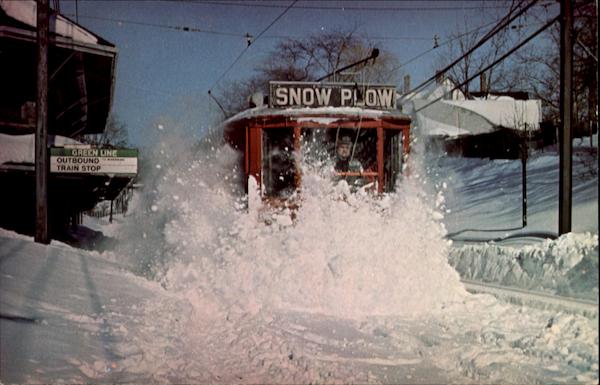Has anyone ever suggested snow sheds over the T tracks where above ground, to help avoid snow-related issues?
The Fields Corner-Ashmont tunnel on the Red Line
is a de facto snowshed. The old Shawmut Branch cut through Dorchester was notorious for having a wind angle facing the direction of the Neponset River which collected monster snowdrifts that routinely suspended Old Colony commuter trains during and after big storms. When Red was built there 90 years ago they replaced some partial metal snowshed sections from the RR era with a full air rights roof to lick that drifting problem forever. But that was the one perfect-storm ROW in the whole city that was unusually susceptible to that phenomenon, so a big outlier not found anywhere else. We have ROW's with a nasty wind-facing side and track-level flood risk like the Blue Line in Revere, but that's why they chose overhead lines instead of third rail out there: pantographs make for much better ice-cutters than third-rail shoes, and the electrical plant is pole-mounted instead of in ground conduits. The only snowdrift considerations are maybe a well-placed retaining wall opposite an ocean-facing platform that's got particularly nasty windward side. Which might be a good addition to Assembly Sq. sooner or later because that blow from high off the Mystic is rather unpleasant in February.
You don't need snowsheds unless you're going to be literally buried in drifts taller than a train or face an avalanche risk off the side of a mountain. Neither of those conditions are in-play on the generally slushy (and warming) Southern New England coast. The only reason the system melted down in 2015 was state-of-repair. Too many third rail heaters and switch heaters were inoperable on all 4 color lines so the above-ground rapid tracks failed en masse under what was historically-speaking not unusually difficult snow dumps (i.e. light-and-fluffy, not heavy waterlogged Blizzard of '78 snow). And the vehicle fleets--rapid transit + commuter rail--were so worn out with so many traction motors living on borrowed time with so little manpower resources for staying on top...that all it took was pressure and time for those old motors to suck in enough snow to short out en masse. Well-maintained fleets would not do that.
This is how much New England snow
should have fazed a well-maintained systemwide fleet:
https://vine.co/v/OP9YFebzX27 (<-- That would be an oldest-of-old F40PH-2C locomotive making complete mincemeat of post-Blizzard snowdrifts at full 60 MPH on a Worcester Line rush hour train in West Newton in Feb. 2015 within hours of one of the blizzards). The PCC's were the first vehicles back on the streets after the Blizzard of '78:
(^re-opening the D Line in '78 with a snowplow-converted Type 3 trolley from 1907)
This winter resiliency stuff the FCMB funded was to catch up on the deferred-maint Achilles heels that specifically exploited the system in 2015: the third rail heaters on Red and Orange, switch heaters on all 4 color lines (but Blue in particular), and fragile traction motors on the oldest Orange and Red cars that have to last another 5 years (Green getting help via the Type 7 rebuild program hitting halfway point, and commuter rail now having the full HSP-46 fleet in-service). And they've beefed-up the supply of snowplows so they aren't so S.O.L. for accumulations that pile up
after the "snowbuster" non-revenue trains can no longer run mid-storm. More of the same licks the remaining problems. It's just a very big SGR hole to dig out of. That's the only reason why the system got so much more crippled in 2015 than much worse and more paralyzing storms in decades past. The same shit that fails every single day on a deferred-maint system, just subject to more pressure-over-time by icy conditions. We don't have to fortify the system for
snowier conditions when the annual snow was there centuries of local civilization before the first transit line, and we definitely don't have to fortify it for snow in a climate change era that's getting warmer (floods from sea level rise...different story). General-purpose systemic disrepair can just never be allowed to get as bad and as threadbare as it was in 2015, or proverbial perfect-storm conditions (any such conditions...not even 'storm-storm') can take out the whole works. That's the lesson we learned bitterly in 2015.


